Related Research Articles
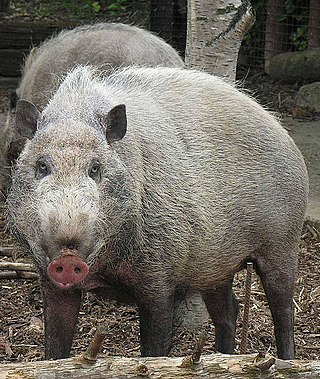
Sus is the genus of domestic and wild pigs, within the even-toed ungulate family Suidae. Sus include domestic pigs and their ancestor, the common Eurasian wild boar, along with other species. Sus species, like all suids, are native to the Eurasian and African continents, ranging from Europe to the Pacific islands. Suids other than the pig are the babirusa of Indonesia, the pygmy hog of South Asia, the warthogs of Africa, and other pig genera from Africa. The suids are a sister clade to peccaries.

Palawan, officially the Province of Palawan, is an archipelagic province of the Philippines that is located in the region of Mimaropa. It is the largest province in the country in terms of total area of 14,649.73 km2 (5,656.29 sq mi). The capital and largest city is Puerto Princesa which is geographically grouped with but administered independently from the province. Palawan is known as the Philippines' Last Frontier and as the Philippines' Best Island.

Tawi-Tawi, officially the Province of Tawi-Tawi, is an island province in the Philippines located in the Bangsamoro Autonomous Region in Muslim Mindanao (BARMM). The capital of Tawi-Tawi is Bongao.

Lubang Island is the largest among the seven islands in the Lubang Group of Islands, an archipelago situated to the northwest of the northern tip of the island of Mindoro in the Philippines. It is positioned approximately 40 kilometers west of Calatagan, Batangas, or 117 kilometers southwest of Manila. The Lubang Group of Islands is under the jurisdiction of the province of Occidental Mindoro and divided into two municipalities. The principal settlement is the town of Lubang, located at the northwest section and about 11 kilometers northwest of Tilik Port. The southeastern portion of the Lubang Island falls within the municipality of Looc, which also operates a port in a different area, specifically in Barangay Agkawayan. Lubang Group of Islands stands as a distinct geographical entity isolated from any landmass, rendering it biologically unique and also endangered.
Palawan is the largest island of the province of Palawan in the Philippines and fifth-largest by area and tenth-most populous island of the country, with a total population of 994,101 as of 2020 census. The northwest coast of the island is along the Palawan Passage in the eastern South China Sea, while the southeast coast forms part of the northern limit of the Sulu Sea. Much of the island remains traditional and is considered by some as under-developed. Abundant wildlife, jungle mountains, and some white sandy beaches attract many tourists, as well as international companies looking for development opportunities.
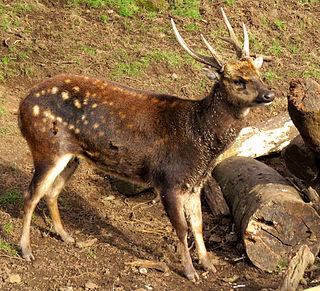
The Visayan spotted deer, also known as the Visayan deer, the Philippine spotted deer or Prince Alfred's deer, is a small, endangered, primarily nocturnal species of deer found in the rainforests of the Visayan Islands of Panay and Negros. It once was found across other islands, such as Cebu, Guimaras, Leyte, Masbate, and Samar. It is one of three endemic deer species found in the Philippines, although it was not recognized as a separate species until 1983. An estimated 2,500 mature individuals survived worldwide in 1996, according to the IUCN; today’s surviving wild number is uncertain. The diet of the deer, which consists of a variety of different types of grasses, leaves, and buds within the forest, is the primary indicator of its habitat. Since 1991, the range of the species has severely decreased and is now almost co-extensive with that of the Visayan warty pig.

The Bornean bearded pig, also known as the Sunda bearded pig or simply bearded pig, is a species in the pig genus, Sus.
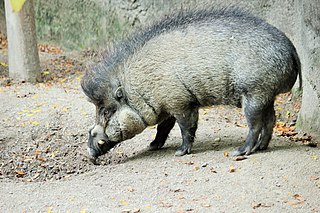
The Visayan warty pig is a critically endangered species in the pig genus (Sus). It is endemic to six of the Visayan Islands in the central Philippines. It is known by many names in the region with most translating into 'wild pig': baboy ilahas, baboy talonon, baboy sulop, and baboy ramo.

The Philippine warty pig is one of four known species in the pig genus (Sus) endemic to the Philippines. They have tufts of hair on the top of their head and on the lower sides of their jaws, as well as four warts on their faces. Their skulls are elongated; males have tusks and bigger skulls than females, an example of sexual dimorphism. They are considered Vulnerable by the IUCN, and their population is currently declining due to multiple threats. The pigs are probably nocturnal.

The Celebes warty pig, also called Sulawesi warty pig or Sulawesi pig, is a species in the pig genus (Sus) that lives on Sulawesi in Indonesia. It survives in most habitats and can live in altitudes of up to 2,500 m (8,000 ft). It has been domesticated and introduced to a number of other islands in Indonesia.

The Javan warty pig, also called Javan wild pig, is an even-toed ungulate in the family Suidae. It is endemic to the Indonesian islands Java and Bawean, and is considered extinct on Madura. It is listed as Endangered on the IUCN Red List since 1996.
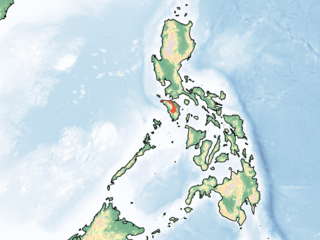
Oliver's warty pig or Mindoro warty pig is a small species in the pig genus (Sus) which can only be found on the island of Mindoro in the central Philippines. This species previously treated to be a subspecies of S. philippensis, was shown to be morphologically and genetically different.

Mount Malindang is a complex volcano located in the province of Misamis Occidental in the southern island of Mindanao, Philippines. It is the highest point in the province. The least studied mountain range was formed through several volcanic activities some of which could be historical, evident by the presence of two calderas, surrounded by high rock walls, cinder cones, dome volcano plugs, two sulfurous hot springs, and a crater lake named Lake Duminagat. The amphitheater structures have extensive distribution of volcanic rocks, carbonized wood that are found in pyroclastic deposits. The mountain range is dissected by several canyons and ravines.

Mount Hamiguitan is a mountain located in the province of Davao Oriental, Philippines. It has a height of 1,620 metres (5,315 ft). The mountain and its vicinity has one of the most diverse wildlife populations in the country. Among the wildlife found in the area are Philippine eagles and several species of Nepenthes. Some of the latter, such as the Nepenthes peltata and Nepenthes micramphora, are endemic to the area. The mountain has a protected forest area of approximately 2,000 hectares. This woodland is noted for its unique pygmy forest of century-old trees in ultramafic soil, with many endangered, endemic and rare species of flora and fauna.

The Palawan bearded pig is a pig species in the genus Sus endemic to the Philippines, where it occurs on the archipelago of islands formed by Balabac, Palawan, and the Calamian Islands. It is 1 to 1.6 m in length, about 1 m (3.3 ft) tall and weigh up to 150 kg (330 lb).

The wildlife of the Philippines includes a significant number of endemic plant and animal species. The country's surrounding waters reportedly have the highest level of marine biodiversity in the world. The Philippines is one of the seventeen megadiverse countries and is a global biodiversity hotspot. In 2013, 700 of the country's 52,177 species were listed as threatened.

The Luzon tropical pine forests are a tropical coniferous forest ecoregion of the Philippines in the western Pacific Ocean. These pine forests are home to a large number of the island's endemic plants and animals.
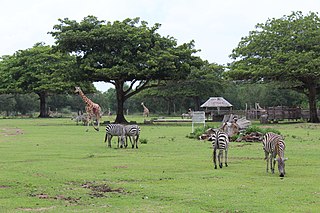
Calauit Safari Park is a wildlife sanctuary in the Philippines which was originally created in 1976 as a game reserve featuring large African mammals, translocated there under the orders of President Ferdinand Marcos during his 21-year rule of the country.
Domesticated animals in the Philippines include pigs, chickens, water buffalo, goats, cats, and dogs. Domestication is when a species is selectively bred to produce certain traits that are seen as desirable. Some desirable traits include quicker growth and maturity, increased fertility, adaptability to various conditions, and living in herds. Domesticated animals play an important socioeconomic role in the Philippines, as seen through their widespread use in rituals.

The Greater Negros–Panay rain forests ecoregion covers the central Visayan Islands in the Philippines, including the islands of Panay, Negros, Cebu, Masbate, Sibuyan, Ticao, Guimaras, Romblon, Tablas, Siquijor, and Bohol, but excludes Leyte and Samar. During the last ice age, these were all on the same island. The lack of a land bridge to Asia during the ice age kept most Asian megafauna, including elephants and tigers, from reaching the Philippines and the Visayan Islands, which hosts many unique and endemic species with some exclusive only to an island.
References
- ↑ Pigs, Peccaries, and Hippos Status Survey and Action Plan, Chapter 5.6, Philippine Warty Pigs (1993)
- ↑ "Synopsis of Philippine Mammals". May 15, 2011. Archived from the original on May 18, 2011. Retrieved April 8, 2020.
- ↑ Lucchini, V., Meijaard, E., Diong, C. H., Groves, C. P. & Randi, E. 2005. New phylogenetic perspectives among species of South-east Asian wild pig (Sus sp.) based on mtDNA sequences and morphometric data. Journal of Zoology 266, 25-35.
- ↑ Asian Wild Pig News, Asian Wild Pig Research and Conservation Group, Vol. 2 (1) (January 2002).
